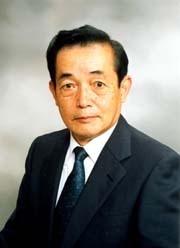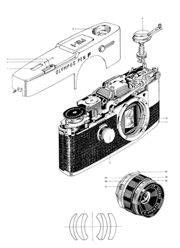
yoshihisa maitani
architect of many (**) olympus camera series

yoshihisa maitani architect of many (**) olympus camera series |

Yoshihisa Maitani |
Without doubt one of the finest minds in camera design and development Yoshihisa Maitani was actively head-hunted whilst at University by Eiichi Sakuria, boss of Olympus who signed him up to join the Olympus Optical Company rather than his chosen career, that of automobile engine design.
Mr. Maitani joined the company in 1956 and spent his first two years familiarising himself with the various parts of the company before being assigned to the Development group. Early in 1958 he was given the task of designing a 'cheap' camera to fill a gap in the company's product range. His only target criteria was its selling price, 6000 Yen. After many attempts and much self criticism he recalled the lesson of one of his university lecturers and stripped the problem right back to basics. Whilst prepared to economise on virtually everything else, he stubbornly refused to fit a cheap lens to his new camera. Instead he insisted on a Tessar type triplet lens thus setting his colleague Yoshisada Hayamizu a formidable challenge, to produce such a well specified fully moving lens at such a low price. Many of the Pen's design features, including the choice of format, were the result of Mr. Maitani's cost paring, although his response to my questions about design inspiration might come as a surprise. Some five different 'mock-up' models were made, much to the astonishment of his design colleagues. The Pen Original went into production in October 1959 made by a sub contractor and I reveal its name. Once again readers may be surprised at my findings. So huge a success was this new product, Olympus took over Pen production in 1960 and this gem of design was set to dominate the half frame market for the next two and a half decades. Mr. Maitani now leads the design team to develop the viewfinder Pen and in the next five years huge technological advances are made including automatic exposure (Pen EE) and the world's first fully automatic motor-drive/rewind half frame camera (Pen EM.) Interestingly, Mr. Maitani has little to say about the beleaguered Pen EM.
|

Pen F - Exploded diagram |
His next challenge is to design a Single Lens Reflex System camera based on the enormous success of the viewfinder Pen. Thus challenged he produces in 1963 another world first - the Olympus Pen F System - a half frame SLR, an array of top quality lenses, system accessories and with the Pen FT in 1966 the first TTL metering. With a new rotary shutter that synchronises at all shutter speeds this is a remarkable achievement, and still a young man. In spite of its huge popularity elsewhere, the Pen series is considered unsuccessful in the important USA market as they have poor half-frame developing services. Where now? Even though he had surpassed all expectations with the Pen series of cameras, Mr. Maitani's real ambition lay in designing a full frame SLR. As early as 1967 he turned his mind to this next challenge. In an age of large, clumpy, noisy full frame SLR's he designs a tiny full frame 35mm SLR system camera that leads the field and in 1972 the world is introduced to the Olympus M1. It could have been smaller but his design reflects a photographers insight, and a truly remarkable system camera is born that sets the standard for years to come. How does the designer follow that? With remarkable vision he concentrates on the next generation of cameras, sculpturing in clay a small, compact and pocketable camera that is to be copied by all others. Of extremely high quality, offering manual and semi-automatic features with no need for case or lens cover, he produces the XA range of 'capsule cameras.' His design genius can be seen in many of the later Olympus offerings, particularly the Mju range that goes from strength to strength. From the Pen designed down to a price, to the OM system that boasted over 260 components, the designer remains what he always has been - a photographer. He could not fulfill his dream by mechanical sophistication, though he tried. But his ultimate vision of making a photograph as easy as recalling a memory is almost here now with the digital age. Salutations, Yoshihisa Maitani - your contribution has been enormous. |
|
HOME |
INTRO |
BOOKS |
OLYMPUS CIRCLE |
QUEST |
TOC MEMBERS |
GALLERIES
|
| Posted 2004/12/12 | Copyright © 2004 John Foster |